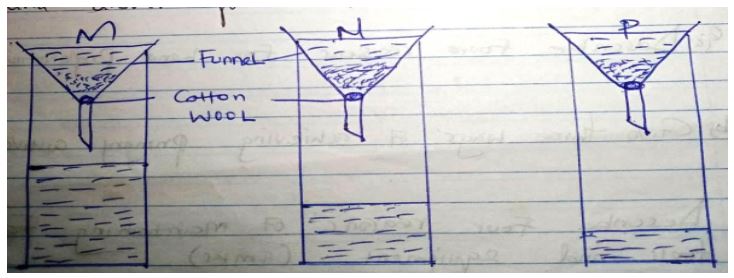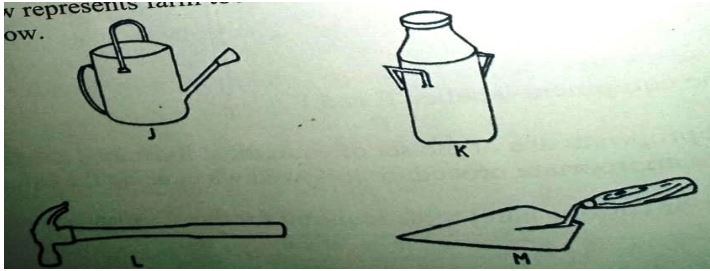- Define the following terms
- Pomoculture (1mk)
- Floriculture (1mk)
- Name three forms of livestock production (3mks)
- Give the differences between the following
- Plantation farming and ranching (2mks)
- Small scale farming and large-scale farming. (2mks)
- Name three biotic factors that influence agriculture positively. (3mks)
- State three underground water sources (3mks)
-
- Describe four reasons for land preparation (4mks)
- Give three ways of achieving primary cultivation (3kms)
- Describe four reasons of maintaining farm tools and equipment (4mks)
- Name four aspects of rainfall that affect crop distribution in Kenya (4mks)
- Give four benefits of good soil aeration. (4mks)
- State four uses of water in the farm (4mks)
- Give four reasons why burning is discouraged as a method of land clearing (2mks)
SECTION B (30 MKS)
ANSWER ALL QUESTIONS IN THE SPACES ROVIDED.
- Form one students carried out the following experiment to investigate a certain aspect of soil using three types of soil M, N and P. Study the diagrams and answer questions that follow.
- State the aim of the experiment above (1mk)
- Name the type of soil labeled M, N and P (3mks)
- Describe three ways of improving soil type M (3mks)
- Distinguish between soil structure and soil texture. (2mks)
- The diagram below illustrates a tertiary operation carried out in the farm.
- Identify the tertiary operation. (1mk)
- State three importance of the tertiary operation identified in (a) above. (3mks)
- The diagram below represents farm tools and equipment. Study them and answer the questions that follow.
- Identify the tool / equipment labeled: (4mks)
- J
- K
- L
- M
- State one use for each tool / equipment labeled K and L. (2mks)
- Give three maintenance practices for the equipment labeled K. (3mks)
- Identify the tool / equipment labeled: (4mks)
- The diagram below represents a surface drainage method. Study it and answer the questions that follow.
- Identify the drainage method above (1mk)
- State four benefits of drainage as a land reclamation method in crop production. (4mks)
- Give three maintenance practices carried out on a knapsack sprayer (3mks)
SECTION C (30 MKS)
ANSWER ALL QUESTIONS IN THIS SECTION IN THE SPACES PROVIDED
- Name four types of water pumps which can be used in the farm (4mks)
- Describe reasons for practicing irrigation in Kenya (5mks)
-
- List four types of soil structure (4mks)
- Describe effects of soil structure on crop production. (4mks)
- Give reasons for treating water in the farm before use. (4mks)
- Describe the effects of soil pH on crop production. (4mks)
- State the farming practices that help to achieve minimum tillage. (5mks)
MARKING SCHEME
SECTION A (40 MKS)
ANSWER ALL QUESTIONS IN THE SPACES PROVIDED
- Define the following terms
- Pomoculture (1mk)
- Growing of fruits (1X1=1mk)
- Floriculture (1mk)
- Growing of flowers (1X1=1mk)
- Pomoculture (1mk)
- Name three forms of livestock production (3mks)
- Apiculture / Bee keeping
- Aquaculture / fish production
- Beef and dairy production
- Poultry farming
- Rabbit production (3X1=3mks)
- Give the differences between the following
- Plantation farming and ranching (2mks)
- Plantation farming is growing one type of crop on large scale while ranching involves rearing beef animals on large scale in the arid and semi arid areas. (2X1=2mks)
- Small scale farming and large-scale farming. (2mks)
- Small scale farming is the type of farming carried out on a small piece of land while large scale farming involves growing crops and rearing of animals on a large piece of land for commercial purposes. (2X1=2mks)
- Plantation farming and ranching (2mks)
- Name three biotic factors that influence agriculture positively. (3mks)
- Pollutants
- Decomposers
- Nitrogen fixing bacteria
- Predators (3X1=3mks)
- State three underground water sources (3mks)
- Wells
- Boreholes
- Springs (3X1=3mks)
-
- Describe four reasons for land preparation (4mks)
- To kill weeds
- To kill pests by exposing them to be scorched by the sun
- To aerate the soil
- To incorporate manure and organic matter into the soil for faster decomposition
- To break hard pans
- To improve water infiltration (4X1=4mks)
- Give three ways of achieving primary cultivation (3mks)
- Use of ox plough
- Hand cultivation using simple hand tools eg. Jembes
- Mechanical cultivation eg. Using disc ploughs (3X1=3mks)
- Describe four reasons for land preparation (4mks)
- Describe four reasons of maintaining farm tools and equipment (4mks)
- Avoid injury to the user
- Avoid damage to the tool
- Reduces cost of replacement of tools
- Increases durability of tools
- Ensures that tools work more efficiently (4X1=4mks)
- Name four aspects of rainfall that affect crop distribution in Kenya (4mks)
- Rainfall amount
- Rainfall distribution
- Rainfall reliability
- Rainfall intensity (4X1=4mks)
- Give four benefits of good soil aeration. (4mks)
- Promote root respiration
- Promote germination of seeds
- Promote growth of soil microbes e.g. Nitrogen fixing bacteria
- Promote absorption of nutrients by active transport (4X1=4mks)
- State four uses of water in the farm (4mks)
- Watering livestock
- Mixing and diluting chemicals e.g. herbicides
- Recreational uses e.g. swimming
- Irrigation
- Cleaning farm tools, equipment and structures
- Domestic uses e.g. cooking, washing utensils (4X1=4mks)
- Give four reasons why burning is discouraged as a method of land clearing (2mks)
- Destroys soil structure
- Kills soil micro – organisms
- Leaves land bare exposing it to soil erosion
- Fire may spread to unintended areas
- Destroys organic matter (4X1=4mks)
SECTION B (30 MKS)
ANSWER ALL QUESTIONS IN THE SPACES ROVIDED.
- Form one students carried out the following experiment to investigate a certain aspect of soil using three types of soil M, N and P. Study the diagrams and answer questions that follow.
- State the aim of the experiment above (1mk)
- To investigate drainage and water holding capacity of soil M, N and P (1X1=1mk)
- Name the type of soil labeled M, N and P (3mks)
- M – sandy soil
- N - Loam
- P – Clay soil
- Describe three ways of improving soil type M (3mks)
- Apply organic manure
- Apply organic mulch
- Liming soil
- Irrigation
- Apply inorganic fertilizers (3X1=3mks)
- Distinguish between soil structure and soil texture. (2mks)
- Soil structure is the general appearance of soil in relation to the arrangement of various soil particles while soil texture is the fineness or coarseness of soil particles when felt in between the fingers. (2X1=2mks)
- State the aim of the experiment above (1mk)
- The diagram below illustrates a tertiary operation carried out in the farm.
- Identify the tertiary operation. (1mk)
- Ridging (1X1=1mk)
- State three importance of the tertiary operation identified in (a) above. (3mks)
- Improves drainage
- Allows tuber expansion
- Allows soil and water conservation
- Allows easier harvesting of tuber crops e.g. Irish potatoes (3X1=3mks)
- Identify the tertiary operation. (1mk)
- The diagram below represents farm tools and equipment. Study them and answer the questions that follow.
- Identify the tool / equipment labeled: (4mks)
- J – Watering can
- K – Milk churn
- L – Claw hammer
- M – Mason’s trowel (4X1=4mks)
- State one use for each tool / equipment labeled K and L. (2mks)
- K – Holding milk during transport and storage
- L – Driving in nails and removing nails from wood / straightening nails
- Give three maintenance practices for the equipment labeled K. (3mks)
- Through cleaning
- Disinfecting after use / sterilizing
- Painting with aluminum paint to prevent rusting
- Repair / replace broken / worn out parts (3X1=3mks)
- Identify the tool / equipment labeled: (4mks)
- The diagram below represents a surface drainage method. Study it and answer the questions that follow.
- Identify the drainage method above (1mk)
- Cambered beds
- State four benefits of drainage as a land reclamation method in crop production. (4mks)
- Improvement of soil structure
- Raising the soil temperature
- Lowering the water table hence making the production of certain crops possible
- Improving aeration of the soil
- Increases volume of soil
- Reduce soil erosion
- Get rid of toxic substances
- Get rid of mosquito breeding habitats (4X1=4mks)
- Give three maintenance practices carried out on a knapsack sprayer (3mks)
- Clean after use
- Grease the moving parts
- Tighten loose nuts and bolts
- Repair broken parts
- Unblock blocked nozzle
- Proper storage
- Replace worn out parts
- Painting / apply oil metallic parts
- Identify the drainage method above (1mk)
SECTION C (30 MKS)
ANSWER ALL QUESTIONS IN THIS SECTION IN THE SPACES PROVIDED
- Name four types of water pumps which can be used in the farm (4mks)
- Centrifugal pump / rotor dynamic pumps
- Reciprocating / piston pumps
- Semi rotary pumps / hydram
- Rotary pumps / hydraulic pumps (4X1=4mks)
- Describe reasons for practicing irrigation in Kenya (5mks)
- Enables farmers to grow crops during the dry season
- Enables farmers to grow crops which require a lot of water e.g. paddy rice
- Source of employment if used on large scale
- Enables farmers to grow crops in structures like green houses
- Supplements rainfall if not enough to grow crops
- It is a method of land reclamation thus allowing farmers to grow crops in arid and semi – arid areas
-
- List four types of soil structure (4mks)
- Single – grained
- Crumby
- Blocky
- Platy
- Columnar
- Prismatic
- Granular (4X1=4mks)
- Describe effects of soil structure on crop production. (4mks)
- Influences soil drainage
- Influences water holding capacity of soil
- Influences soil aeration
- Influences microbial activities e.g. decomposition
- Influences root penetration (4X1=4mks)
- List four types of soil structure (4mks)
- Give reasons for treating water in the farm before use. (4mks)
- To remove bad smell and taste
- To kill pathogens / disease causing organisms
- To remove physical impurities e.g. sticks, leaves
- To remove chemical impurities e.g. excess fluoride (4X1=4mks)
- Describe the effects of soil pH on crop production. (4mks)
- Determines the type of crop to grow in an area
- Affects availability of nutrients e.g. phosphorus is not available in acidic soils
- Affects microbial activities e.g. Nitrogen fixing bacteria do not do well in acidic soil
- Affects resistance of crops to soil – borne pests e.g. resistance of Irish potatoes tonnematodes is reduced in acidic soils. (4X1=4mks)
- State the farming practices that help to achieve minimum tillage. (5mks)
- Cover cropping
- Mulching to smother weeds
- Use of herbicides to kill weeds
- Slashing weeds
- Uprooting weeds
- Timely weeding (5X1=5mks)
Download Agriculture Questions and Answers - Form 1 Term 3 Opener Exams 2023.
Tap Here to Download for 50/-
Get on WhatsApp for 50/-
Why download?
- ✔ To read offline at any time.
- ✔ To Print at your convenience
- ✔ Share Easily with Friends / Students





